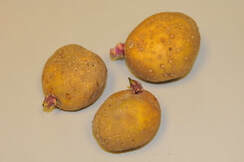 Home gardeners have had to rely on proper storage conditions (cool and moist) to prevent potatoes from sprouting. But sprouting will eventually occur even if the gardener does everything right. Research by Mary Jo Frazier, Nora Olsen and Gale Kleinkopf from the University of Idaho have found products that should help home gardeners. These researchers were looking for an organic method to control potato sprouts. They found essential oils from some herbs and spices to be effective sprout inhibitors. Specifically they found that spearmint oil, peppermint oil and clove oil suppressed sprouting by physically damaging rapidly dividing cells in the sprout. Each of these products is so safe that the FDA has approved them for addition to food. Several application methods were considered though most were only suitable for commercial storage facilities. The only practical method for homeowners was one the researchers labeled a “low-tech” wick method. This was accomplished by placing a small piece of blotter paper saturated with spearmint or peppermint oil in a box with the potatoes. This method was not recommended for the clove oil. Though it was found that peppermint and spearmint oils were equally effective in suppressing sprouts, the peppermint oil was less likely to affect flavor of the potatoes. Reapplication at two- to three-week intervals will be needed for continued sprout suppression. Little to no residue was found on the potatoes from these products due to their high volatility. The first application should be done before sprouting occurs. Blotting paper is much more difficult to find than it was in the past and so you may want to substitute blank newsprint. However, if blotting paper is desired, try herbarium supply houses. Blotting paper is used to press plant specimens. (Ward Upham) 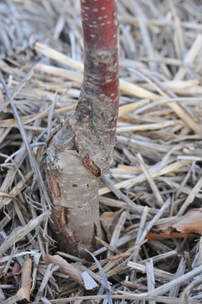 We occasionally receive calls from gardeners who want to know how to treat an apple seed so it will germinate. Usually, the gardener is trying to reproduce an old apple tree that was special for some reason (good quality fruit, planted by grandparents, etc.) Unfortunately, apples grown from seed will not be like the parent. About 1 in every 80,000 apple trees grown from seed will be as good as the apples we are used to eating. Apple trees grown from seed usually have small and inferior quality fruit. If you want a tree exactly like the parent, you must propagate that tree vegetatively. In the case of apples, this usually means grafting for homeowners. Apple trees are actually quite easy to graft, even for novices. Don't be afraid to try even if you haven't grafted before. The step that needs to be done at this time of year is the choosing and cutting of scion wood or small branches that will be grafted on top of a rootstock. See the accompanying article in this week’s newsletter for instructions on how to collect scionwood. If you don’t have an existing tree to graft onto, you will need to plant a rootstock this year for grafting onto next. Fruit trees are normally grafted (or budded) onto specially selected rootstocks. These rootstocks usually reduce tree size. For example, a tree that normally would reach 25 feet tall will only reach 10 feet if it is grown on a certain rootstock. Dwarfing rootstocks also allow apples to bear fruit a year or more earlier. Note that rootstock reduces tree size, not fruit size. Therefore, a Golden Delicious tree that only reaches 8 feet tall due to a dwarfing rootstock, will bear the same size fruit as a Golden Delicious tree that is 25 feet tall. A tree on its own roots normally takes 5 to 7 years before it will bear. Semi-dwarf trees bear in 4 to 5 years, and dwarf trees bear in 3 to 4 years. Unfortunately, not all dwarfing rootstocks are well adapted to Kansas conditions. Semi-dwarf trees usually are a better choice for us. Fully dwarfed trees often are uprooted or break at the graft during high winds. Semi-dwarf trees are usually more than 50% the size of a standard (non-dwarfed) tree. So, where do you buy rootstocks to graft onto? Most nurseries only sell trees that are already grafted. A company that does sell rootstocks is Raintree Nursery, Morton, WA, (360) 496-6400, http://www.raintreenursery.com/Rootstocks/ Another is Cummins Nursery, (865) 233-3539, http://www.cumminsnursery.com/rootstocks.htm though there is a minimum shipping and handling fee of $20. What rootstock is best? There are a several choices that should work well in Kansas. An old favorite is Malling-Merton (MM) 111 as it is well-adapted to Kansas conditions and can tolerate heavier soils. Trees will be 80% the size of a “standard” tree. Malling-Merton (MM) 106 is a good choice for well-drained soils. Trees will be about 70% the size of a standard tree. Other rootstocks can be used but make sure they are well-anchored and not described as brittle. It is also possible to buy a tree from a local nursery and graft your clone onto a side branch. This will give you one tree that produces two different apples. One disadvantage of this method is that it is possible to prune off the special clone by mistake in later years. This information does not include the details of grafting or budding or subsequent care. The Missouri Extension Service has an excellent publication on grafting at http://extension.missouri.edu/explorepdf/agguides/hort/g06971.pdf as well as a second publication on budding at http://extension.missouri.edu/explorepdf/agguides/hort/g06972.pdf . If you use a knife, be sure to practice your cuts on wood you prune off in March. After you do about 100 cuts, you will start to get the hang of it. A grafting tool can make this job even simpler as it makes the proper cut automatically. Do a search on “grafting tool” to see what is available. (Ward Upham) 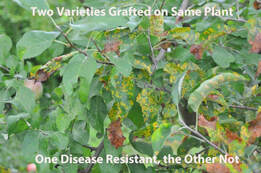 Nurseries often sell apple trees that bear more than one variety of fruit. The secret is grafting. All apple trees are grafted, which is done by grafting the apple-producing variety (the scion) on a variety chosen for its dwarfing effects (the rootstock). A tree with more than one variety simply has more than one fruiting variety grafted onto a single rootstock. Grafting allows growers to have a single tree that could produce Jonathan, Red Delicious and Golden Delicious apples. These trees can be a unique attraction and a good conversation point in a fruit garden. If space is limited, a multiple grafted tree may allow growers to have a greater variety of fruit than with individual varieties on separate trees. However, there are some possible drawbacks. Whoever prunes the trees may not recognize the individual grafts and may unknowingly prune off one of the varieties. Also, varieties may vary in vigor, and stronger varieties can crowd weaker ones. There also may be a difference in susceptibility to disease among varieties and among different kinds of fruit. Some may have resistance to a disease and not require protection, but others are susceptible and do require protection. If the susceptible fruits are protected, the more resistant ones will be sprayed unnecessarily. (Ward Upham) 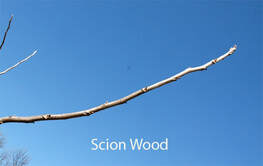 If you are planning on doing any grafting this spring, now would be a good time to collect scionwood. Following are tips on how to choose good scion wood. - Scions should be cut from one-year-old wood. - Buds should be prominent and widely spaced. Water sprouts work well for this. Water sprouts are twigs that grow straight up from a major branch. - Inner bark should be light green and the wood creamy white. - Best scions have more wood than pith; small diameter wood often has wide pith. - Older bearing trees produce poor scions unless pruned heavily. The best scions are toward the top of the tree. You may need a pole pruner even for small trees. - Cut shoot into 6-8 inch pieces having at least 3 buds per stick. - The best scion is often the basal piece. - Always discard the terminal (the end piece). - Store in the refrigerator in a plastic bag with moist paper towels. If you are unfamiliar with grafting but would like to learn, the University of Missouri has an excellent publication at http://extension.missouri.edu/explorepdf/agguides/hort/g06971.pdf . Practice your technique on wood you pruned off in March. Try doing about 100 cuts. (Ward Upham) 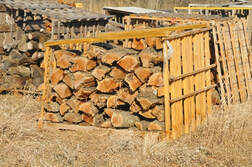 In order to avoid energy costs, some homeowners are turning to wood for heat. Plant species is an important consideration as not all trees have the same density and therefore, heat value. The greater the dry weight, the better. The highest value for trees commonly found in Kansas is osage orange (hedgeball tree) at 4,800 pounds per cord. Osage orange has a gnarly growth habit and a nasty set of thorns. This species also sparks which isn’t a problem in a wood-fired boiler but certainly would be in an open fireplace. Black locust is next with 4,200 pounds per cord. Black locust is a fast grower and also has excellent burning qualities and makes a nice bed of coals. However, it is hard to split, suckers, and has some relatively small thorns, especially on young trees. Bur oak and red oak come in at 3,800 and 3,500 pounds per cord respectively but are not fast growers. Mulberry, however, has the same weight as red oak but grows more quickly. Silver maple has less heat value (3,000 pounds per cord) but is a very fast growing tree. Black locust is a tempting choice for this purpose due to its heat value and fast growth. However, black locust suckers and is invasive and can spread to areas you don’t want and so be careful if you choose this species. Another species, such as mulberry may work better for you. Or consider planting several different species in rows. So, how do you set out your plantation? Dr. Wayne Geyer, our late forestry professor, did many woody biomass studies over a period of 35 years. Following are some recommendations that have come out of his studies. - Plant on a close spacing, 4 to 6 feet apart. This maximizes yield and reduces side branching. - Control weeds the first two years. - Harvest every 5 years though slower growing trees will take longer. Most trees will resprout and can be reharvested. - Plant about 1 acre per year for 5 years if you wish to supply the majority of the firewood needed to heat your home. Trees mentioned above and available from the Kansas Forest Service include mulberry, osage orange, bur oak, red oak and silver maple. (Ward Upham) 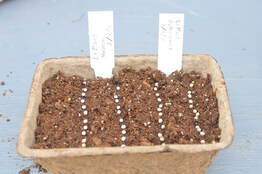
If you start vegetable plants indoors, it is often helpful to list seeding dates on a calendar so that plants are ready for transplanting at the proper time. To do this, choose your transplant date and count back the number of weeks necessary to grow your own transplants. For example, cabbage, broccoli, and cauliflower are usually transplanted in late March to early April. It takes 8 weeks from seeding to transplant size. Therefore, plants should be seeded in early February.
Information on how many weeks it takes to grow transplants is available in our January 7 newsletter at: https://hnr.k-state.edu/extension/info-center/newsletters/2020/Jan7_2020_01.pdf Below are examples of some common vegetables grown for transplants and a recommended date for seeding. Dates are Saturdays as this is when many homeowners have the most free time. The dates are not set in stone, and a week earlier or later will not ruin the plants. Also, you may want to seed a week or two earlier if you are in southern Kansas and possibly a week later if you are in northern Kansas. Calendars can be reused year after year by a slight reset of the dates. Also keep notes on how well the transplants did so you can tweak the planting schedule. Your conditions may result in plants that need a bit more or a bit less time.
Crop Seeding Date Transplant Date Cabbage, Broccoli & Cauliflower February 1 March 28 Lettuce (if you grow transplants) February 1 March 28 Peppers March 14 May 9 Tomatoes March 21 May 2
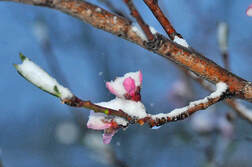 If you are considering purchasing fruit trees this spring, there are certain factors that should be considered for some of our fruit tree species. Spring in Kansas is often unsettled with apricot and peach tree flowers being very vulnerable to late frosts that can kill fruit buds. Of course, the tree itself will be fine but there will be no to little fruit for that year. Other species of trees can also be affected but apricots and peaches are by far the most sensitive. Also, the closer a tree is to full bloom, the more sensitive it becomes to frost. Apricots are more likely to have frost kill flowers than peaches because they bloom a bit earlier. Though there are late-blooming apricot varieties, the differences between full bloom on early and late-blooming varieties appears to be slight. Research at Virginia Tech in the 90's showed a maximum of a 4-day difference between early and late varieties. However, in some years that may be all that is needed. The trees in the study that were considered late blooming included Hungarian Rose, Tilton and Harlayne. Harglow was not included in the study but is also considered late-blooming. See https://pubs.ext.vt.edu/422/422-761/422-761.html for more info. Peaches are next on the list for being likely to be caught by a late frost. With peaches, two characteristics become important when considering whether they will be damaged. Like apricots, bloom time is very important but fruit bud hardiness should also be considered. In this case, fruit bud hardiness refers to hardiness to late frosts rather than the ability to survive extreme low temperatures during the winter. Late bloomers included ‘China Pearl’, ‘Encore’, ‘Intrepid’, and ‘Risingstar.’ See http://aces.nmsu.edu/pubs/research/horticulture/RR782.pdf . The ‘Intrepid’ cultivar also has shown excellent cold hardiness when in flower. See http://www.google.com/patents/USPP12357 So, are there other considerations when looking at possible frost damage? Location can be very important. Planting on a hill which allows cold air to drain to lower elevations can help. Also, a location in town will be more likely to have a warmer micro-climate than an exposed location. Some gardeners will add a heat source under a tree during cold nights if they are close to a building. Heat lamps and charcoal briquettes are sometimes used but safety should be the first consideration. (Ward Upham) 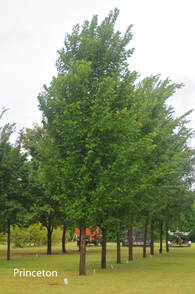 Our John C. Pair Horticultural Center near Wichita established a National Elm Trial in 2007 with 18 cultivars. All of these are Dutch Elm Disease (DED) Resistant with 4 being true American elms. The cultivar ‘Jefferson’ would have been a fifth true American elm but proved to be the same cultivar as ‘Princeton’. The remainder are either hybrids or other elm species. The four true American elms are ‘Valley Forge’, ‘Princeton’, ‘New Harmony’ and ‘Lewis and Clark’ (Prairie Expedition). All have shown excellent tolerance to DED. Characteristics listed below are primarily from our study at the John C. Pair Horticultural Center but storm breakage is from the University of Minnesota. ‘Valley Forge’ Survival: 100% Crown Shape: Vase Lacebug damage to foliage: Minimal European elm flea weevil damage: Minimal Storm Breakage: Fair Comments: Strong grower, broad spreading ‘Princeton’ Survival: 100% Crown Shape: Vase Lacebug damage to foliage: Minimal European elm flea weevil damage: Minimal Storm Breakage: Fair Comments: Impressive grower, upright habit, attractive tree ‘New Harmony’ Survival: 100% Crown Shape: Vase and round Lacebug damage to foliage: Significant European elm flea weevil damage: Minimal Storm Breakage: Not in Minnesota study Comments: Narrow, upright habit with strong, central axis ‘Lewis and Clark’ (Prairie Expedition) Survival: 80% Crown Shape: Broad oval Lacebug damage to foliage: Minimal European elm flea weevil damage: Minimal Storm Breakage: Good Comments: Strong grower with broad spreading habit, some wetwood. Storm damage can be minimized by pruning when the tree is young. Maintain a central leader but prune out all lower branches as the tree grows and branches increase in diameter so that there is room to work under the tree. Also prune out branches attached with a narrow angle as these are most likely to give way in ice or wind storms. For more information regarding the study, see https://webdoc.agsci.colostate.edu/bspm/NationalElmTrial/AUF2017.pdf For photos and information on hybrids and other species of elm, see https://webdoc.agsci.colostate.edu/bspm/ElmKansas.pdf . (Ward Upham) |
AuthorsCynthia Domenghini runs the Horticulture Response Center in the Department of Horticulture and Natural Resources at Kansas State University. Other contributors include K-State Extension Specialists. Archives
March 2024
Categories
All
|
| K-State Research and Extension Horticulture Newsletter |
|
 RSS Feed
RSS Feed
